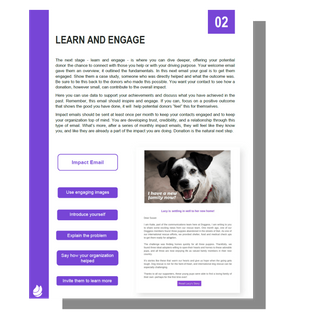Donor Retention: How to Measure and Improve Donor Loyalty


Existing donors have already demonstrated that they believe in the work you do. They heard your nonprofit’s message and decided to give some of their cold, hard cash to help your organization achieve its goals. It stands to reason that people who have already given are more likely to give again, right?
Right.
This study found that marketing to the uninitiated results in about 17% of those people giving to your cause, on average. But this other study found that of donors who have given before, 34% will give again. That’s double. So while it makes perfect sense to look for new donors, you may find that your time spent with previous donors is more rewarding.
What Is Donor Retention?
Donor retention occurs when you turn existing donors into repeat, loyal supporters. You’ve retained them from one year to the next. Another donor retention definition is that it’s a way to describe your strategy for encouraging gifts from existing donors.
How to Calculate the Donor Retention Rate
There are three ways to calculate donor retention rates:
1. Overall Retention Rate
The percentage of total donors from last year who gave again this year.
(returning donors year 2/donors year 1) x 100 = donor retention %
2. First-Time Donor Retention Rate
The percentage of donors who gave for the first time last year and donated again this year.
(returning first-time donors in year 2/first time donors in year 1) x 100 = first time donor retention %
3. Repeat Donor Retention Rate
The percentage of retained donors from last year gave again this year.
(returning donors in year 3/retained donors in year 2) x 100 = repeat donor retention %
Why Is Donor Retention Important?
On the surface, it may seem like it doesn’t matter whether your donors are new or returning, as long as they are giving to your cause, right? Not so fast. There are a few, very important reasons that you should care about donor retention.
a. Affordability
Maintaining relationships with existing donors requires less time and money than forming new relationships. You already have their email addresses, they follow you on social media, and maybe you have their physical mailing address, so your communication can be targeted, specific, and cost-effective rather than scattershot and expensive.
b. Sustainability
Nonprofits are subject to the same fiscal and economic ups and downs as for-profit businesses, so there are always going to be times of feast and times of famine. So when the going gets tough, it’s great to have a committed foundation of supporters that you can draw on to get your organization through.
c. Loyalty
With the right encouragement, donors who have given year after year are going to become your evangelists, the supporters who will talk about your organization to friends, family, coworkers, the cashier at the grocery store, and anyone else who will listen, growing your network and boosting your signal strength.
See How Nonprofits Use Keela To Improve Donor Loyalty
How to Build an Effective Donor Retention Strategy
1. Know Your Donors and Their Interests
Most donors give for highly personal reasons, at different times of the year, in varying amounts, and they expect different levels and formats of communication both before and after a donation.
While that makes it sound impossible to fundraise, it really isn’t. By using a few tools and tactics to better understand your donors, you can begin to learn what keeps them coming back and use that information to hone your communications.
a. Donor Personas
Building a set of donor personas can help you outline archetypes for your supporters: the wealthy annual donor, the small monthly donor, the donor who needs a reminder, etc. By segmenting your audience into personas, you can more easily target specific groups that you know are more likely to become repeat donors.
b. Donor Journey
Knowing who your donors are is important; knowing where they are in their journey is critical. Mapping out a donor’s journey helps you to understand how and when a donor gives and interacts with your nonprofit, so you know when to communicate when to ask for a donation, and when to start your journey together again.
c. Donor Surveys
Sometimes in order to get the information you need, you just have to ask. If there are holes in your database that you need to be filled in order to help retain donors, send a survey and get it straight from the horse’s mouth.
2. Follow Up After Receiving a Donation
It takes more than a single thank you to keep your donors engaged. Donors want actual recognition of their individual contributions; they also want to feel like they are part of a movement that is doing something good for the world.
So thank them and tell them how their donation is going to help. Give them updates about your impact. Ask them questions. Invite them to participate in other ways, like volunteering or attending events. Send them relevant, inspiring content that nurtures their interest in your cause. And don’t ask for more money every time you send an email.
Here is an excellent timeline to follow after receiving a donation.
3. Send Better Thank You Letters
While it’s very important that you thank your donors, how you thank them is a major factor in donor retention too. A physical thank you letter sent via snail mail works wonders with older donors, while a concise and beautiful thank you email is great for more tech-savvy audiences.
Don’t forget that things in the mail take time to reach their destination, so send those envelopes as quickly as possible. And check out this article for a few more tips and templates.


FREE Donor Thank You Letter Templates
We know creating a thank you letter, or email from scratch can be a challenge. We create a guide and 7 customizable templates to thank donors, volunteers, sponsors, and more!
6 Ideas for Your Donor Retention Strategy
1. Create a Welcome Series
Retention starts right away. As soon as your donor has given, thank them. Then send a series of emails specifically intended for that type of donor—first-time, returning, longtime, etc. Receiving communications that are meant to welcome someone makes them feel as though they are part of your community. Here is a deeper look at welcome series planning.
2. Give Regular Updates on Your Impact
If you can demonstrate that donations to your organization are doing actual good, donors will be more likely to give again in the future. Two great strategies are sharing testimonials and celebrating wins.
a. Testimonial – BackBack Buddies
In this example, BackPack Buddies sent an email thanking the donor and sharing direct quotes from beneficiaries of their generosity that thank the donor (again) and tell brief stories about their impact.
b. Celebrating a Win – The Humane Society
In this example, The Humane Society shares an account of what is happening on the ground in their field and shows how donations can result in significant positive outcomes around the world.
3. Write a Compelling Newsletter
If you’re going to take the time to write a regular email newsletter, you should make sure it’s effective. Here are literally dozens of ideas that will help you construct the most compelling newsletter possible. Just don’t try to do all of them at once—no one wants to read a newsletter that looks like it was written by Tolstoy.
4. Offer Membership Privileges
A lot of donors are happy to give out of the goodness of their hearts. Some give because they love to come up with a juicy tax receipt every April. But don’t discount the slice of your audience that would give, or give more, if they were offered privileges and rewards.
Attaching dollar amounts to a tiered membership system, like the one shown here, is a great way to get donors to boost their contributions and come back year after year. Once you’ve been awarded the prize bike jersey for raising $1,000, it’s hard to think about raising less the following year.
5. Use Social Media
The shortest distance between you and your donors is Facebook. Or Instagram. Or maybe Twitter or LinkedIn. You get the idea: social media is amazing for quickly and intimately connecting with your audience. Use that power to encourage engagement and loyalty in donors who you’d love to see again and again.
Host a Q&A, follow up on a survey, show your impact, explain and discuss issues surrounding your cause, and the list goes on. Just make sure it’s all social media friendly: not too long, not too controversial, easily shareable, and use photos and video wherever possible. More great info here.
Lastly, it’s a good idea to make your donor retention strategy part of your overall nonprofit marketing plan. Building it into your schedule of activities will make it easier to execute, month after month, year after year, as you build your legion of regular supporters.



